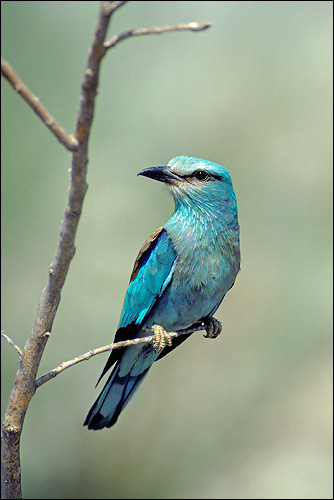Eurasian Roller (Coracias garrulus)
The Roller is a “perch and pounce” predator of the warm, sunny, insect-rich parts of Europe. It sits on a lookout point between 3 and 6 m above ground, observing the comings and goings of prey below, and then goes after whatever it has spotted by a shallow, leisurely glide down and a quick grab. The meal is then brought back to a perch and beaten senseless against a hard surface before being swallowed. The prey sought is typically between 10 and 30 mm long. Large beetles are usually the predominant prey, but overall it is possible to make a long list of the items that might be consumed. Most of them are various insects, but scorpions are important in places, and frogs, lizards and even snakes are caught sometimes. The snakes may be as long as 35 cm, and may take some time to despatch and eat.
Rollers pair up in their winter quarters, which is just as well, because they are late arriving in Europe. They settle into a territory and the male defends it vigorously, using the flight-display that gives this bird its English name. It flies up at a sharp angle beating its wings hard, stalls at a height of 200 m or more, then dives down, calling, rolling its body from side to side until it almost touches the ground, whereupon it swoops up again and the sequence is repeated. The display is directed at any strange bird, and sometimes at other intruders, such as people, too.
All Rollers migrate in the autumn to East Africa and Central Africa, where they join all the birds that breed anywhere from Europe to China, making the Roller an abundant bird there. They travel by day in small groups, apparently averaging 67 km per day overall.
Habitat Open forests (especially of oak and pine), steppe and grassland in warm, sunny climates.
Food Invertebrates and small vertebrates such as lizards and snakes. Indigestible parts are ejected from the mouth as pellets, about 10 times a day.
Movements A summer migrant wintering mainly in East Africa. It departs in August and returns in May.
Voice A guttural “rak”, often repeated.
Pairing style Monogamous. Some pairs apparently tolerate a third bird in the territory, but its role, if any, is not yet understood.
Nesting Solitary and territorial.
Nest A hole, usually in tree, but sometimes among rocks or even old building. Holes made by Black or Green Woodpeckers are most popular. No material.
Productivity 1 brood a year.
Eggs 4-5.
Incubation 17-19 days, by both adults, but only by female at night.
Parenting style Young fed by both adults.
Young Nest-bound, altricial and naked.
Food to young As adult food.
Leaving nest Young fledge at 25-30 days, and become independent 3 weeks later.

